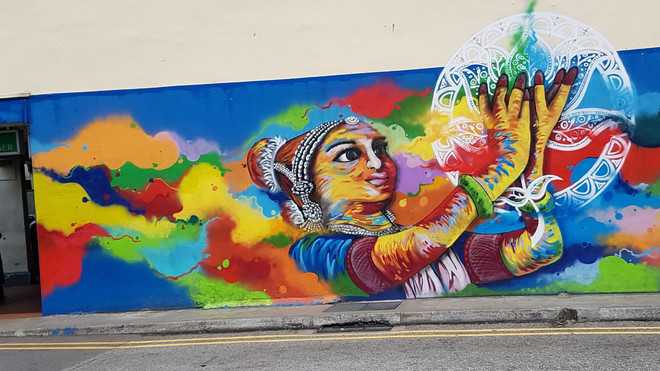
Art unblocked: Kathakali, Bharatnatyam and Odissi dancers dressed in their traditional finery cover walls in Little India
Vandana Aggarwal
Located in the tourist enclave of Singapore’s Little India, colourful paintings have immortalised the lifestyle of Indian immigrants who have made Singapore their home for over 200 years.
Many of these murals were painted by students of La Salle College of the Arts as part of the Artwalk Little India festival, with support from the Little India Shopkeepers and Heritage Association. The artworks, some of which are as high as 14m and as wide as 10m, lend a vibrant feel to the area.
A step in history
The arrival of the original immigrants from India to Singapore can be traced back to the early 1800s, when the British established a colony in Singapore. Indians came as part of the army, as convicts or as traders, looking for business opportunities.
Paying homage to the early immigrants is a wall painted with cattle. It is colourful and whimsical at first glance, but look deeper and it draws attention to the thriving cattle trading that was the mainstay of business in Little India in the old days.
One of the cows is depicted riding a bicycle which used to be the common man’s means of transport. The cows and buffaloes have now been replaced by a bustling market of all-things Indian, but the cattle remind us of a past when men went from door to door selling milk, and bullock carts were used to carry goods.
Culture as craft
Hidden in one of the alleys is a wall painted golden, showcasing what seems to be designs of every shape. This is an ode to the jewellery stores still found abundantly in Little India. Indians have traditionally enjoyed wearing gold and buying it as an asset. Even today, Little India is dotted with shops sparkling with this precious metal. Businesses that are now disappearing, but had once been the mainstay of Indians here, also make their presence felt. There is a family of dhobi, depicted as they wash, dry and carry the laundry. Then, there is an astrologer with his mystical parrot. In one of the bylanes, there is a man selling titbits. Present also is a tea seller who in the past must have been the focal point of the immigrants, who would get together to discuss their day and news from home.
Colourful and life like, these murals bring alive history in a unique manner, deepening our knowledge and appreciation of Singapore’s rich cultural past. Various temples dot Little India and the garland makers and flower sellers who play an important role in Hindu rituals also find themselves immortalised on one of the walls. The man on a horse dressed in the style of a western jockey may seem out of place, but it actually alludes to the Singapore Race Course that had originally been located in Little India.
Making present bright
The murals are not all about the past. A larger than life wall-painting of Rajinikanth overlooks a car park. Rajinikanth, a hero of the masses and a symbol of an ordinary person having made good, is a role model to thousands of migrant workers, who swarm the streets of Little India on weekends. Another touching tribute to these workers is paid in the mural where a worker in a yellow helmet is tending to a mogra plant. The plant is a symbol of growth and blossoming of Singapore and the determination of these hardworking men.
Pillars at the popular Tekka Market have been decorated with some cricketing action. Both local Indians and new immigrants share a love for cricket. Some walls have striking paintings of musicians and dancers. There are Kathakali, Bharatnatyam and Odissi dancers with expressive faces, dressed in their traditional finery.
These large-scale murals creatively exemplify the vibrancy of Little India and reveal some facets of the Indian community life that is fast disappearing. They are a reminder that Indians may have travelled far from their country of origin but they have never forgotten their roots. And that they have not just carried their cultural traditions with them, but also kept them alive.



























